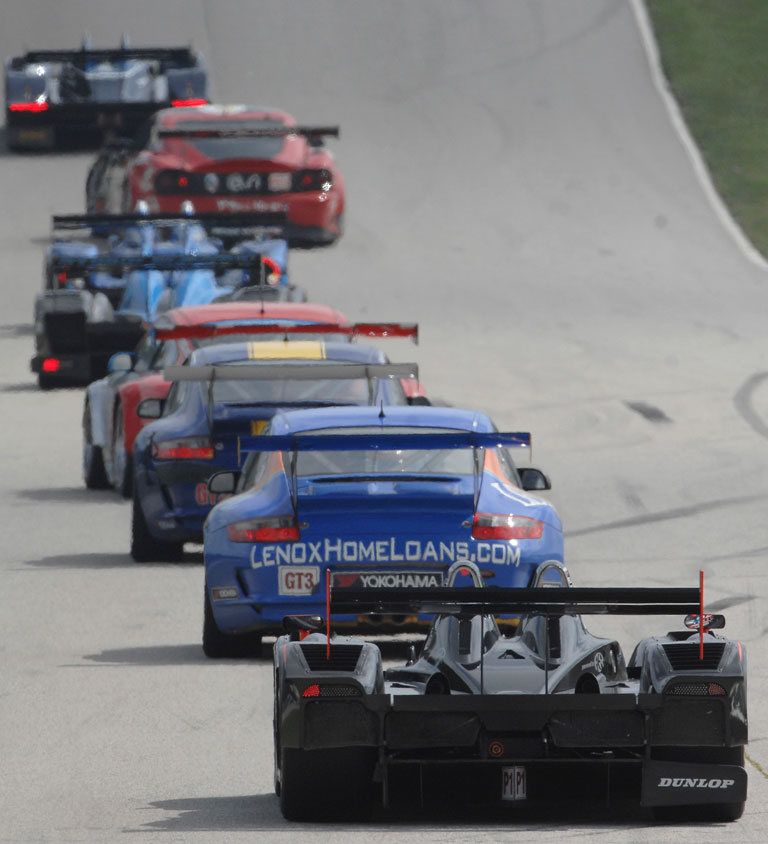Is the ALMS half empty or half full?
 |
The American Le Mans Series’ announcement at Road America of its consolidation of the LMP and GT classes – coupled with the introduction of the LMP Challenge class – will provide pundits and seers with plenty to chew on in the coming weeks and months. Purists will doubtless decry the introduction of a dreaded “spec" series to an arena whose raison d’être is diversity and technical innovation, not homogenization and technical stasis. Pragmatists will embrace a decision that, in one fell swoop, makes for a rational consolidation of four classes into two while promising perhaps a half-dozen new, high-tech – albeit identical – prototype-esque entries to the grid.
Rather than purists and pragmatists, Series boss Scott Atherton preferred the “is the glass half empty or half full" analogy in his public comments at Road America. From the “half empty" perspective, he readily conceded that, as with the Challenge GT cars added to the field earlier this year, one aim of introducing the LMP Challenge cars is to increase numbers. But, as he was quick to note, it is not the only aim or outcome of a Challenge class. From the “half full" point of view, he noted that at least one current Challenge program is planning to move up to GT2 in 2010. So in addition to bulking up what – from the perspective of mid-August ’09 – otherwise promises to be a gossamer thin prototype entry next year, the LMP Challenge class may provide entry to the “real" prototype class.
 |
Others were also thinking long-term…say ’11 and beyond. With the ACO expected to announce its rules for 2011 shortly – rules that are widely anticipated to reduce if not eliminate the unfair advantage enjoyed by diesel-engined prototypes since ’06 – there were some at Road America who viewed the LMP Challenge and class consolidation as a move to bridge the Series circa ’09 and ’11. In other words, it is a move to get the Series over the hump of what figures to be a challenging ’10 campaign (at least prototype-wise) and into an ‘11 season that could see a renaissance of multi-manufacturer involvement in prototypes coinciding with the new ACO rules and – we can all hope – a robust economic recovery.
On the race track, meanwhile, Road America proved without a doubt the GT2 – soon to be just GT – class is alive and well. BMW earned its first pole of the season for its new M3 (and its new partnership with Rahal Letterman Racing) and went on to an impressive 1-2 in the race itself. Corvette was again competitive in just the second outing of its GT2 car, and grabbed third place when Johnny O’Connell took advantage of a late-race bobble by Patrick Long in the Flying Lizard Porsche.
Although BMW deep-sixed its Formula One program and Formula BMW Americas, the Bavarians did so while sending clear signals that its American Le Mans Series program is exactly the kind of motorsports venture that makes sense to them. Porsche? Absent from the podium for the first time since Sebring (two Ferraris and a Panoz) and barring the remote possibility that its evolving relationship with Audi and VW will contravene the fundamental laws of physics, it will remain a bulwark of the GT class. Although Ferrari’s plans are a little murky but with Corvette planning to sell its new car to privateers, the GT class figures to be on solid ground; solid enough that the day may soon arrive when the GT Challenge cars are no longer needed to inflate the grid.
And that raises the possibility that should the LMP class enjoy a rebirth in 2011, we could see another tweak to the structure, one that puts the two Challenge classes – GT and LMP – in a race of their own while their big brothers are left to duke it out among themselves. With IMSA Lites, this would give American Le Mans Series a true ladder system the likes of which sports car racing has seldom before enjoyed.
There’s another equally intriguing dimension to the LMP Challenge category. With a fixed price of $380,000 for a turn-key car, a targeted budget of $1 million for a season of racing and driver qualification rules that will more or less require a pairing of a pro and gentleman driver in each entry, the LMP Challenge could look very attractive to some teams and team owners now competing in the Rolex Grand-Am Series Daytona Prototypes; particularly those “gentleman" owners and/or drivers who no longer have the requisite talent (or budget) to compete with the full-on professional programs…and who find the prospects of racing at Sebring, Long Beach, Lime Rock, Road America, Mosport and Road Atlanta enticing.
All of this borders on, if not goes well into, the realm of pure speculation. Much of this will not even begin to become clear until the end of 2009, indeed until 2011. One thing is certain however. After years of kowtowing to an ACO that is focused on the unique dynamics of the 24 Hours of Le Mans; of being at the mercy of manufacturers’ sometimes capricious decisions; of taking the high road in the face of spurious annual rumors of an impending fire sale; and with its dramatic consolidation of classes and introduction of GT and now the LMP Challenge classes, the American Le Mans Series has come out swinging.
David Phillips is one of North America’s most respected and renowned motorsports journalists. His ‘Another Turn’ feature appears regularly on americanlemans.com. The opinions expressed do not necessarily reflect the views of the American Le Mans Series.
